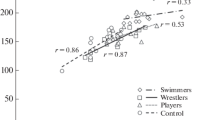Abstract
The relationship between the dynamics of cardiorespiratory parameters of elite rowers determined in ergospirometer testing and their performance in 2000- and 6000-m Concept II rowing ergometer contests was analyzed. The analysis showed a strong correlation between sports results and physiological parameters, such as the maximal oxygen consumption in absolute units, oxygen consumption at the aerobic threshold and respiratory compensation point, fat-free body mass, maximum attainable power of performance, and powers at the aerobic threshold and respiratory compensation point, despite the substantial period of time between the contests and the functional ergospirometer tests.
Similar content being viewed by others
References
Winter, E.M., British Association of Sport and Exercise Sciences. Sport and Exercise Physiology Testing: Guidelines: the British Association of Sport and Exercise Sciences Guide, vol. 1: Sport Testing, New York: Routledge, 2006.
Secher, N.H., Physiological and Biomechanical Aspects of Rowing. Implications for Training, Sports Med., 1993, vol. 15, no. 1, p. 24.
Shephard, R.J., Science and Medicine of Rowing: A Review, J. Sports Sci., 1998, vol. 16, p. 603.
Riechman, S.E., Zoeller, R.F., Balasekaran, G., et al., Prediction of 2000 m Indoor Rowing Performance Using a 30 s Sprint and Maximal Oxygen Uptake, J. Sports Sci., 2002, vol. 20, no. 9, p. 681.
Ingham, S.A., Whyte, G.P., Jones, K., and Nevill, A.M., Determinants of 2000 m Rowing Ergometer Performance in Elite Rowers, Eur. J. Appl. Physiol, 2002, vol. 88, no. 3, p. 243.
Kramer, J.F., Leger, A., Paterson, D.H., and Morrow, A., Rowing Performance and Selected Descriptive, Field, and Laboratory Variables, Can. J. Appl. Physiol., 1994, vol. 19, no. 2, p. 174.
Steinacker, J.M., Physiological Aspects of Training in Rowing, Int. J. Sports. Med., 1993, vol. 14, no. Suppl 1.
Bourgois, J., Claessens, A.L., Vrijens, J., et al., Anthropometric Characteristics of Elite Male Junior Rowers, Br. J. Sports. Med, 2000, vol. 34, no. 3, p. 213.
Yoshiga, C.C. and Higuchi, M., Rowing Performance of Female and Male Rowers, Scand. J. Med. Sci. Sports, 2003, vol. 13, no. 5, p. 317.
Messonnier, L., Freund, H., Bourdin, M., et al., Lactate Exchange and Removal Abilities in Rowing Performance, Med. Sci. Sports Exercise, 1997, vol. 29, no. 3, p. 396.
Maestu, J., Jurimae, J., and Jurimae, T., Monitoring of Performance and Training in Rowing, Sports Med., 2005, vol. 35, no. 7, p. 597.
Raslanas, A., Specific Features of Anaerobic and Aerobic Processes in the Organism of High Sport-Class Rowers, Fiziol. Chel., 1999, vol. 25, no. 4, p. 106 [Human Physiol. (Engl. Transl.), vol. 25, no. 4, p. 467].
Carter, J. and Jeukendrup, A.E., Validity and Reliability of Three Commercially Available Breath-By-Breath Respiratory Systems, Eur. J. Appl. Physiol., 2002, vol. 86, no. 5, p. 435.
Rietjens, G.J., Kuipers, H., Kester, A.D., and Keizer, H.A., Validation of a Computerized Metabolic Measurement System (Oxycon-Pro) During Low and High Intensity Exercise, Int. J. Sports. Med., 2001, vol. 22, no. 4, p. 291.
Doherty, M., Nobbs, L., and Noakes, T.D., Low Frequency of the “Plateau Phenomenon” During Maximal Exercise in Elite British Athletes, Eur. J. Appl. Physiol., 2003, vol. 89, no. 6, p. 619.
Wasserman, K., Whipp, B.J., Koyl, S.N., and Beaver, W.L., Anaerobic Threshold and Respiratory Gas Exchange During Exercise, J. Appl. Physiol., 1973, vol. 35, no. 2, p. 236.
Wasserman, K., Hansen, J.E., Sue, D.Y., et al., Principles of Exercise Testing and Interpretation, Philadelphia: Lippincott Willians and Wilkins, 1999, 3rd edition.
Davis, J.A., Anaerobic Threshold: Review of the Concept and Directions for Future Research, Med. Sci. Sports Exercise, 1985, vol. 17, no. 1, p. 6.
Hagerman, F.C., Connors, M.C., Gault, J.A., et al., Energy Expenditure During Simulated Rowing, J. Appl. Physiol., 1978, vol. 45, no. 1, p. 87.
Cosgrove, M.J., Wilson, J., Watt, D., and Grant, S.F., The Relationship between Selected Physiological Variables of Rowers and Rowing Performance As Determined by a 2000 M Ergometer Test, J. Sports Sci., 1999, vol. 17, no. 11, p. 845.
Fiskerstrand, A. and Seiler, K.S., Training and Performance Characteristics among Norwegian International Rowers 1970–2001, Scand. J. Med. Sci. Sports, 2004, vol. 14, no. 5, p. 303.
Venables, M.C., Achten, J., and Jeukendrup, A.E., Determinants of Fat Oxidation During Exercise in Healthy Men and Women: A Cross-Sectional Study, J. Appl. Physiol., 2005, vol. 98, no. 1, p. 160.
Ruby, B.C., Coggan, A.R., and Zderic, T.W., Gender Differences in Glucose Kinetics and Substrate Oxidation During Exercise Near the Lactate Threshold, J. Appl. Physiol., 2002, vol. 92, no. 3, p. 1125.
Messonnier, L., Freund, H., Bourdin, M., et al., Lactate Exchange and Removal Abilities in Rowing Performance, Med. Sci. Sports Exerc, 1997, vol. 29, no. 3, p. 396.
Platonov, V.N., Sistema podgotovki sportsmenov v olimpiiskom sporte. Obshchaya teoriya i ee prakticheskie prilozheniya (Athlete Training System in Olympic Sports: The General Theory and Its Practical Applications), Kiev: Olimpiiskaya Literatura, 2004.
Author information
Authors and Affiliations
Additional information
Original Russian Text © O.V. Drarnitsyn, A.M. Ivanova, V.V. Sazonov, 2009, published in Fiziologiya Cheloveka, 2009, Vol. 35, No. 3, pp. 74–81.
Rights and permissions
About this article
Cite this article
Drarnitsyn, O.V., Ivanova, A.M. & Sazonov, V.V. The relationship between the dynamics of cardiorespiratory variables and rowing ergometer performance. Hum Physiol 35, 325–331 (2009). https://doi.org/10.1134/S0362119709030086
Received:
Published:
Issue Date:
DOI: https://doi.org/10.1134/S0362119709030086




